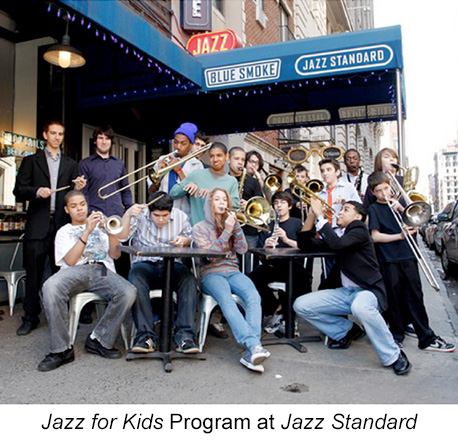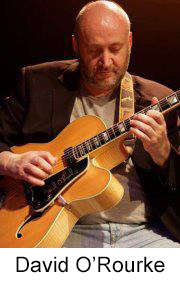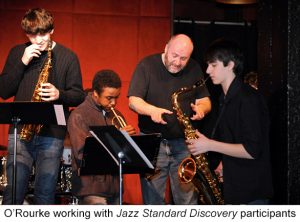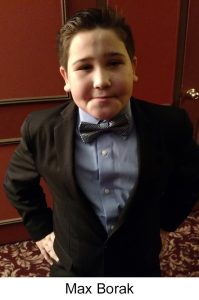 The Marlowsphere Blog (#135)
The Marlowsphere Blog (#135)
It would be easy to make the statement that the younger generation (however you define it) is not being exposed to jazz, America’s classical music, and that is one major reason why jazz is not a popular music anymore.
Well, it would be easy, but it would be a mis-statement for several reasons. Jazz has not been America’s popular music since the end of World War II and the advent of bebop at almost the same time. Jazz went from a dancing and listening music, to a listening music, and sometimes to a hard to listen to and understand music.
Nonetheless, in New York City, at least, there are several ongoing instances of kids, that is students not yet in college, who are being exposed to jazz, not only as listeners, but also as participants. The instances include the jazz program at Fiorello H. LaGuardia High School of Music Art and Performing Arts (used to be the High School of Performing Arts and the Music & Art High School before 1982), the jazz program at the Dalton School, the kids initiatives at Jazz@Lincoln Center, and the “Jazz for Kids” program at Jazz Standard, one of New York City’s leading jazz clubs.
I visited the “Jazz for Kids” program a couple of weeks ago, on October 16—a Sunday—when Jazz Standard opens its doors to a program it has been running and promoting for many years. I arrived at around 11:30 a.m. It was an amazing sight in this  leading basement jazz venue. On the stage—a stage frequented on Monday nights by the Mingus Legacy Band and on other nights by many of the world’s leading jazzers—was a somewhat diminutive young girl (turns out she was nine and a student at Saint Ann’s located in Brooklyn Heights) at the piano performing Gershwin’s “Summertime.” She also worked through the standard “Blue Bossa.” She was accompanied by a much older, and much more accomplished upright bass player and drummer. Granted, she was no Joey Alexander—she played all the chords on “1” and her improvising was highly formative—but nonetheless there she was performing in a jazz trio.
leading basement jazz venue. On the stage—a stage frequented on Monday nights by the Mingus Legacy Band and on other nights by many of the world’s leading jazzers—was a somewhat diminutive young girl (turns out she was nine and a student at Saint Ann’s located in Brooklyn Heights) at the piano performing Gershwin’s “Summertime.” She also worked through the standard “Blue Bossa.” She was accompanied by a much older, and much more accomplished upright bass player and drummer. Granted, she was no Joey Alexander—she played all the chords on “1” and her improvising was highly formative—but nonetheless there she was performing in a jazz trio.
It turned out she was auditioning to become part of Jazz Standard’s “Jazz for Kids” program, a Sunday afternoon program, during the school year, curated by guitarist David O’Rourke.
Irish born David O’Rourke was introduced to the U.S. jazz scene in 1982 via Bucky Pizzarelli and Les Paul. Influenced by Pat Martino (with whom he studied and now collaborates), David has performed with jazz legends Tommy Flanagan, Cedar Walton, Jackie McLean, Billy Higgins, Curtis Fuller, Kenny Davern, Jack McDuff and many more. His arrangements have been recorded and performed by many jazz legends, as well as the RTE Concert Orchestra (Ireland) which he guest conducts. David leads his own 20 piece Big Band (The O’Rourkestra), co-founded and directs NYC’s Jazz Standard Youth Orchestra and the Jazz Standard Discovery Program.
 Following this audition, groups of junior high and high school students one after another took over the stage to rehearse. The quality of the playing was significantly higher, especially the bass players and the drummers. One pianist in particular, a senior level student from LaGuardia High School (at Lincoln Center) displayed a high level of technical ability and confidence. In a very quiet way he commanded not only the piano and the stage, but also the other players.
Following this audition, groups of junior high and high school students one after another took over the stage to rehearse. The quality of the playing was significantly higher, especially the bass players and the drummers. One pianist in particular, a senior level student from LaGuardia High School (at Lincoln Center) displayed a high level of technical ability and confidence. In a very quiet way he commanded not only the piano and the stage, but also the other players.
The instrumentation among the students was what you might expect: piano, bass, drums, guitar, alto and tenor saxophone. The tunes they played also met expectations: “There’ll Never Be Another You,” “Autumn Leaves,” and “Back Home in Indiana,” among other jazz standards. The by-play among the musicians was also standard fare: a few choruses all around, trading fours, and incorporating quotes from the bebop litany, Monk, and “Trane” in their evolving improvisational technique. An appropriate mix of ethnicities was also present: white, African-American, Hispanic, and Asian.
However, the star of the afternoon, for me, at least, was Max Borak, an 11-year-old vocalist who performed Jerome Kern’s Oscar-winning song “The Way You Look Tonight.” Not exactly the kind of tune you would expect an 11-year-old to choose to sing, but then Max Borak is not your usual kid. I spoke with him briefly after he concluded his rehearsal. Turns out his singing model is  Frank Sinatra. Apparently, when he was younger he saw the movie “The Parent Trap” and fell in love with Sinatra’s rendition of the song of the same title. Try to imagine Wayne Newton’s voice in the body of an 11-year-old who is not yet five feet tall. This “kid” displayed poise and audience connection way beyond the norm. His use of the microphone also showed a professional understanding of stage mechanics. You’ll hear from him one day.
Frank Sinatra. Apparently, when he was younger he saw the movie “The Parent Trap” and fell in love with Sinatra’s rendition of the song of the same title. Try to imagine Wayne Newton’s voice in the body of an 11-year-old who is not yet five feet tall. This “kid” displayed poise and audience connection way beyond the norm. His use of the microphone also showed a professional understanding of stage mechanics. You’ll hear from him one day.
The afternoon audience (doors opened at 1 p.m., show time at 2 p.m.; no cover, but the food costs) was mainly parents, friends of parents, and people generally supportive of young people playing jazz. The program benefits everyone: the “kids” who get to perform and gain from the experience, the parents and friends of parents who get to see their kids grow professionally, and the Jazz Standard which gets to bring in an audience on a Sunday afternoon which otherwise would be dark.
The question that has to be posed is this: from what circumstances do these “kids” come to perform jazz? Why aren’t they looking to emulate any number of pop music icons that bombard all forms of media every day? It’s clear each musician understood the correct, professional stage demeanor required, understood how to relate to an audience, and knew how to relate to one another. What is influencing them?
The answer lies in two places. After doing a little questioning with David O’Rourke and several audience members it was obvious that many of the 16 or so students present that afternoon had parents who were either musicians themselves or had connections in some way to the music business or show business. Second, the educational system they were in was also a very strong influence. In this one afternoon they were students there from a specialized school—LaGuardia, a New York City high school one has to audition to get into—or a private school, such as Saint Ann’s or the private school in New Jersey Max Borak attends (even though he lives in Riverdale in the Bronx).
If anything is a truism it’s that where you come from will have a strong influence on your future. Jazz Standard’s “Jazz for Kids” program provides an ongoing environment for these future professional musicians, but it’s the parents and their school environment that provides the evolving talent.
Eugene Marlow, Ph.D.
October 31, 2016
© Eugene Marlow 2016

